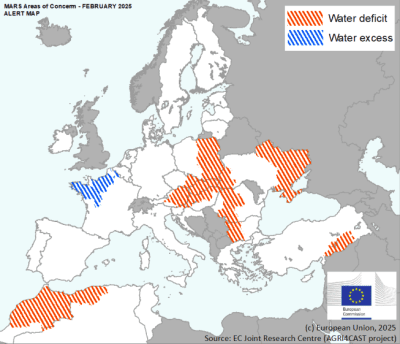European winter crops in reasonable shape as spring approaches

Winter crops in most parts of the European Union are in fair to good condition entering March, but irreversible yield losses have occurred in some regions due to both excessive rainfall and soil moisture deficiencies, according to the February edition of the European Commission’s JRC MARS Bulletin.

Alert map. Areas of concern; water deficit red hatching and water excess blue hatching. Source: EC Joint Research Centre in JRC MARS bulletin February 2025
The torrential rainfall observed in the north-western regions of France in January may not have been extreme in a typical year, but when combined with the already saturated soil profile and relatively low temperatures, it created some quite unfavourable conditions for crop development over the past month, with waterlogging a common issue.
A conspicuous rainfall surplus was also reported in Sardegna and parts of Sicilia in southern Italy, as well as in Estonia’s northern farming regions and Finland’s south-eastern reaches. Cumulative rainfall in many of these regions exceeded the long-term average (1991 to 2024) by as much as 150 percent over winter.
Conversely, a noticeable rainfall deficit has been evident in large parts of central and eastern Europe. Winter crops in western Romania and Bulgaria, particularly, have suffered from limited water availability since the start of the season. A reduction in the harvested area is forecast, although some fields will be resown in the spring if rainfall arrives. Poor soil moisture has also been observed in eastern Lithuania, most of Poland, eastern Czechia, all of Slovakia, significant portions of Austria and Hungary, as well as parts of southern Spain in the west of the bloc.
The lack of snow cover across much of central and eastern Europe is a significant concern. Without a protective snow blanket, winter crops are exposed to an increased risk of frost and winter kill should an intense cold spell sweep through, as experienced in a number of these regions last week.
However, the hardening of winter wheat is more advanced than it was at this time last year. Hardening is the biophysiological process whereby winter cereals develop low-temperature tolerance to withstand freezing conditions during winter dormancy. As ambient temperatures fall, the moisture content in the crown’s cells drop, slowing natural growth and the accumulation of soluble carbohydrates, helping the plant resist frost damage.
The European Commission’s modelling suggesting winter cereals across most of the European Union are fully hardened. Nonetheless, the model does not weigh up the effects of late planting and could be exaggerating the frost tolerance of later sown and underdeveloped winter crops in countries such as Bulgaria and Romania.
Partial or advanced hardening has been reached in western France, the Benelux countries, Denmark, some parts of central and southern Italy, and the cropping regions adjoining the Aegean and Black Seas. As usual, winter crops in most coastal regions bordering the Mediterranean Sea are only slightly hardened, if at all.
Meanwhile, the condition of France’s soft wheat crop declined by one percentage point week-on-week, according to FranceAgriMer, to be rated at 73pc good to excellent as of February 24. This is the second lowest late February score of the past five years, with last year’s 68pc rating as the lowest.
Heavy rainfall stymied crop growth last year, with France harvesting its smallest soft wheat crop since the 1980s. In the ten years prior to the 2024 harvest, France averaged 27.5pc of total EU soft wheat production. With soft wheat production of 25.4 million tonnes (Mt) last year, that dropped to 22.8pc.
On February 11, France’s farm ministry increased its winter wheat area estimate for the 2025 harvest from its December projection of 4.51 million hectares (Mha) to 4.57Mha. This is around 9.1pc higher than the area harvested last year and 0.4pc above the average of the past five years. The ministry noted that plantings in the Centre-Val de Loire region, one of the country’s major cropping regions, were relatively unchanged year-on-year due to waterlogged soil conditions during the autumn seeding period.
FranceAgriMer’s condition rating of the French winter barley crop was unchanged last week at 69pc, a tad lower than last season’s late February assessment of 70pc. The French farmer took advantage of some drier planting windows in the week to February 24, advancing the spring barley planting program by 22 percentage points to 56pc completed. This is up from 27pc at the same time last year when waterlogged fields delayed progress, and ahead of the five-year average of 42pc. Unsettled weather and showers last week slowed the pace, with a return to more favourable seeding weather expected this week.
The autumn planting campaign in Germany was devoid of the previous year’s rainfall delays, with the area sown to winter crops 5.6pc higher year-on-year to 4.8Mha. Winter wheat accounts for 60pc of that area at 2.8Mha, 12.3pc higher than the prior season. Germany is the EU’s second biggest soft wheat producer, averaging 17.9pc of total output.
The nation’s rapeseed area increased by 2.3pc to 1.1Mha and the winter barley area is 5.4pc lower at 1.2Mha. The title race between France and Germany for the EU’s biggest producer is pretty tight for rapeseed and barley, with France averaging 23.8pc and 22.3pc of total EU output over the past ten years, respectively, against Germany with 21.8pc and 20.9pc.
According to Stratégie Grains, oilseed output in the EU is on track for a sizeable rebound this year as crop conditions in most major production jurisdictions remain favourable. It forecast the EU rapeseed crop at 19Mt, 13pc higher than the 2024 harvest and 900,000t above the average of the past ten years.
On the cereal front, Stratégie Grains sees 2025/26 season soft wheat production in the EU-27 increasing by 10.9pc year-on-year to 126.6Mt, on the back of a higher planted area and improved weather conditions compared to last season. However, this year’s barley output is forecast to be unchanged compared to 2024 as higher yields are offset by a smaller planted area across the EU-27 member states.
For almost 30 years of expertise in the agri markets, UkrAgroConsult has accumulated an extensive database, which became the basis of the platform AgriSupp.
It is a multi-functional online platform with market intelligence for grains and oilseeds that enables to get access to daily operational information on the Black Sea & Danube markets, analytical reports, historical data.
You are welcome to get a 7-day free demo access!!!
Read also
Official Release – December 17th! Crop & Price Navigator 2026/27
Ukraine’s harvest nears completion: Total grain output exceeds 56 mln tons
Wheat heads for worst week since June on global oversupply
‘Soybean GPT’ lands South Korea’s agriculture ministry in awkward situation
Thailand purchases 65 thsd tons of Argentine feed wheat
Write to us
Our manager will contact you soon



